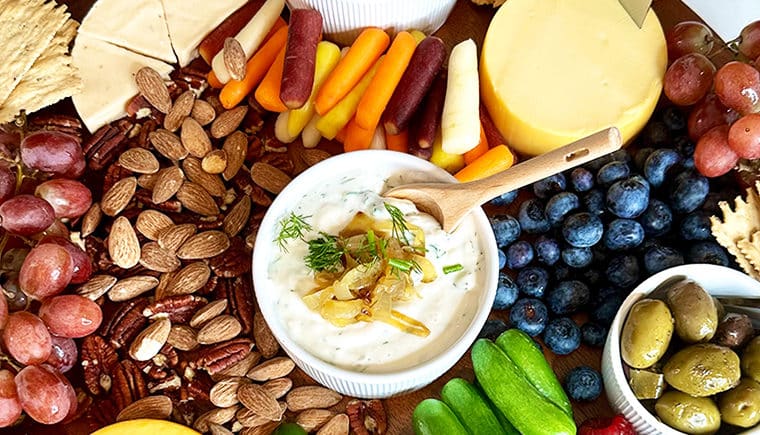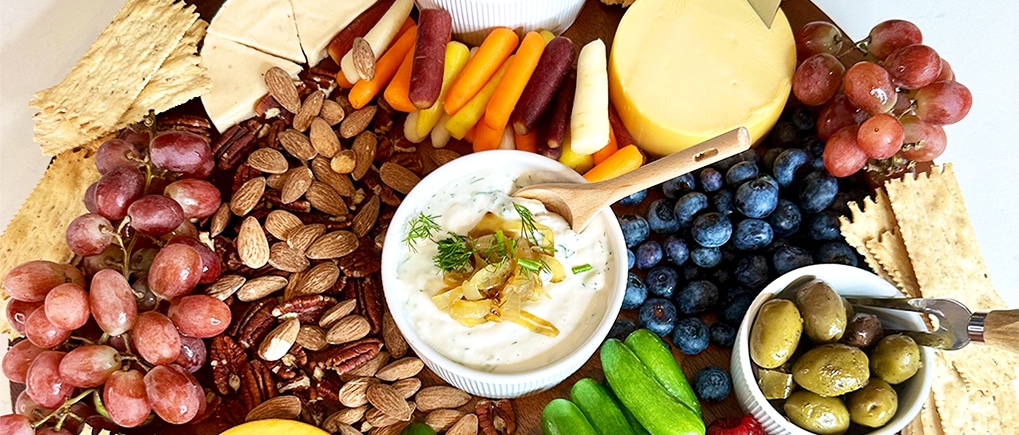



Learn how to take your holiday dinner to the next level by serving a beautiful, delicious, and nutritious vegan charcuterie board.
The holiday season is here! Get your cozy pj’s, gift wrapping paper, warm beverages, and… your vegan cheese charcuterie board ready. A vegan charcuterie board is a great way to host friends and family so you can enjoy each other’s company while snacking on delicious foods.
They are perfect for sharing whenever you have a group of people together. Plus, plant-based charcuterie boards are a great opportunity to introduce new (vegan) cheeses and dips to those who would otherwise not try them on their own. Actually, who are we kidding? It’s a way to impress your guests with delicious plant-based foods they may be unfamiliar with and which they won’t even believe it’s vegan! We’ve compiled a guide to help you assemble the perfect (and healthy) plant-based charcuterie board this holiday season.
“Charcuterie” is a French word that translates to delicatessen, which we know in the U.S. as the famous “deli” where you can buy cured meats, cheeses, bread, and other specialty food items. The charcuterie board, which has become increasingly popular in recent years, is an assortment of fine, snackable foods that can be enjoyed straight from a cheese board, as an appetizer, or even as a main course. Although it traditionally includes cured meats and cheeses, the plant-based version of a charcuterie board delivers the same “wow” factor, deliciousness, and satisfaction as any classic board.
Get a wooden board, tray, or platter as your base for the vegan charcuterie board. You truly can’t go wrong here; whether you choose a round, square, or rectangular board, with handles or without, any board will work. The size of the board depends on the number of people you will be serving it to, as well as your budget. A smaller board requires fewer ingredients, so it is more budget-friendly, but it will only serve a few people. A larger board will cost more, along with the ingredients, but it will serve a larger group. But remember: you want the foods to look abundant, not sparse, so a board that is too large may not look as good.
The size will also depend on whether you want the charcuterie board to be the main attraction of your event or simply a start for appetizers before a meal. You will also need serving utensils, such as cheese knives, small forks for things such as olives, and small spoons for dips.
Finally, you will need small serving bowls for any ingredients that can’t be placed directly on the board (think: hummus, dips, spreads, jams, and olives), as well as small serving plates for people who prefer to place an assortment of foods into their own plate, rather than eating it straight from the board.
Planning what you are going to include in your charcuterie board makes the process much easier and ensures that your board has a variety of flavors, textures, and colors. As a guide, make sure to organize your ingredients into these four categories:
The cool thing about a vegan charcuterie board is that you can make it unique to your taste by choosing your favorite food items. Whether you include store-bought items such as pre-cut vegetables, ready-to-eat hummus, and store-bought vegan cheese, or decide to prep everything at home with tasty products from Forager Project and make your dips and cheeses from scratch, a charcuterie board can be as simple or as complex as you would like. Follow the next steps to determine which foods to include.
A charcuterie board needs its main attraction: cheese. Preferably, choose a vegan cheese that can be sliced or spread on a cracker. Here, you can keep it easy by buying a vegan cheese wheel from the store (luckily, there are many options available nowadays), or you can make homemade vegan cheese (usually made from cashews) by following a recipe online.
Choose 1-3 vegan cheese varieties to include in your board. Dips are also pretty essential to the board, as they provide a different consistency (creamy) to the savory category. Plant-based dip ideas include a garlic dip made with plant-based sour cream, baba ganoush made with cashew-based yogurt, hummus, plant-based herbed ranch or onion dip, or vegan cream cheese Ideally, you want to choose dips that can be served cold.
Now that you have your cheese and dips, you will need something to dip with. Ideally, a combination of crackers, bread, and vegetables is best so you can offer a variety of textures and flavors. Any crackers will suffice: whole grain, gluten-free, with or without seeds, herb-flavored, etc. For bread, you can include soft bread, such as slices of French baguette, or fresh bread, such as sourdough, or you can add crunchy bread, like breadsticks or crostini. Finally, you will need raw vegetables – these will not only add a pop of color but will provide a more nutritious option to enjoy your dips with.
Raw vegetables are best because they are crunchy, juicy, and can be enjoyed cold. We recommend that you include a variety of colored vegetables such as carrots, celery, bell peppers, cherry tomatoes, cucumber, and radishes. Make sure to cut them into sticks or rounds, or serve mini-sized versions such as mini cucumbers and baby bell peppers. Finally, a vegan charcuterie board requires crunchy nuts such as walnuts, almonds, and cashews, which can be either raw or roasted, salted or unsalted.
Whether you have a sweet tooth or not, in order to balance out the saltiness from the cheese and crackers, you will need to add something sweet. A combination of fresh and dried fruits works best, such as fresh berries and dates, but you can also add sweet dips, such as jams or even candied nuts. Finally, you can make chocolate lovers happy by adding dark chocolate squares, dark chocolate chips, or dark chocolate-covered foods such as covered nuts, fruits, or pretzels.
Cheese and crackers contribute much flavor but not much color. By incorporating fresh fruits and vegetables into your board, you will be adding the pop of color it needs to be aesthetically pleasing and picture worthy. Beyond offering an array of vitamins and minerals, fruits and vegetables are essential to making your charcuterie board a masterpiece. Add a variety of colors – from reds and purples in tomatoes, grapes, and berries, to greens and oranges in celery, carrots, and peppers. Make sure the fruits and vegetables are properly washed and dried and pre-cut, so they are easy to grab. If you want to go the extra mile, you can also offer pickled vegetables, such as pickles or pickled onions, as well as different types of olives.
Once you’ve prepped and gathered all the ingredients from the different categories, it’s time to get crafty! First, place your cheese wheel(s) and any ingredients that require small bowls or dishes. This includes your spreads, dips, olives, and pickled vegetables which cannot be placed directly onto the board. You can either place the cheese wheel in the center, or you can space it out with the other dishes, leaving plenty of space in between so you can include your “loose” ingredients.
Next, place the crunchy items of your choice to dip things with – crackers, bread, and vegetables. You can stack them together, forming a line, or you can place them around the dishes and bowls, forming a circle. Try to balance out the colors to enhance the beauty of your board. For example, if you are using two green vegetables, for instance, celery and cucumbers, place them on different sides of the board.
Next, add your sweets – fresh fruits, dried fruits, and chocolate. When serving fruits and vegetables that come with a stem, like grapes or tomatoes on the vine, you can either add them in large bunches for a more aesthetically pleasing board, or you can cut them into smaller clusters to make it easier for people to eat them.
It’s best to assemble the board within an hour or two of serving it, considering that many of the ingredients are perishable and require refrigeration. To make your life easier, you can pre-cut the vegetables, wash your fruits, pour any dips or sauces into dishes, and keep it all refrigerated. If you are making dips and cheese from scratch, do so beforehand and keep it ready in the fridge. Additionally, ingredients that may melt, such as chocolate or coconut-based vegan cheese, may need to be kept refrigerated and only added to the board immediately before serving.
By following these steps, your vegan charcuterie board will not only look like a piece of art, but it will also be delicious, nutrient-dense, and filling. Fruits and vegetables provide an array of vitamins and minerals, while whole grain crackers and wheat bread pack dietary fiber, and finally, plant-based cheeses, dips, and nuts are great sources of protein and healthy fats. Packed full of color, textures, and flavor, this shareable vegan charcuterie board will be a hit around the table, having your guests coming back for more!
Serves: 4-8 people
Ingredients
Instructions
This recipe is best when fresh. Cover and store leftover foods separately.

Carolina Schneider, MS, RD is a writer and registered dietitian specializing in plant-based nutrition. Carolina is the founder of Hungry for Plants, a company dedicated to offering nutrition consulting services.